Introduction
WebSocket technology represents a significant advancement over traditional HTTP when it comes to the demands of modern real-time web applications. By establishing a persistent, full-duplex communication channel, WebSocket enables data to flow seamlessly in both directions after the initial connection is made. This is a stark contrast to the stateless HTTP requests that require a new connection for each piece of data.
This fundamental shift not only slashes latency but also enhances performance, making it a go-to choice for applications that depend on instant data updates.
Applications like live chat services, collaborative editing environments, and streaming platforms stand to benefit greatly from WebSocket's capabilities. It creates a more dynamic and responsive user experience by allowing immediate communication without the overhead and delay of establishing new HTTP connections for every interaction. This efficiency is underpinned by the WebSocket protocol's ability to thrive over a single TCP connection, making it a robust solution for today's interactive web ecosystem.
Advantages of WebSocket APIs over HTTP APIs
WebSocket technology represents a significant advancement over traditional HTTP when it comes to the demands of modern real-time web applications. By establishing a persistent, full-duplex communication channel, WebSocket enables data to flow seamlessly in both directions after the initial connection is made. This is a stark contrast to the stateless HTTP requests that require a new connection for each piece of data.
This fundamental shift not only slashes latency but also enhances performance, making it a go-to choice for applications that depend on instant data updates.
Applications like live chat services, collaborative editing environments, and streaming platforms stand to benefit greatly from WebSocket's capabilities. It creates a more dynamic and responsive user experience by allowing immediate communication without the overhead and delay of establishing new HTTP connections for every interaction. This efficiency is underpinned by the WebSocket protocol's ability to thrive over a single TCP connection, making it a robust solution for today's interactive web ecosystem.
Key Concepts in WebSocket APIs
WebSocket technology has revolutionized the way we think about real-time communication on the web. Unlike the standard HTTP protocol, which is designed for one-off, client-initiated transactions, WebSockets foster a two-way conversation between client and server. This persistent, full-duplex connection allows data to flow freely and instantaneously in either direction, a capability that's especially useful in today's dynamic, inter-connected digital world.
For instance, consider the components of WebSocket APIs: clients, servers, connections, and routes. Each plays a crucial role in the dance of data exchange. Clients, be it a browser or a mobile app, kick off the communication by requesting a WebSocket connection to the server.
Upon acceptance, the server maintains this connection, facilitating a real-time data pipeline where messages can be passed back and forth without the need to establish new connections for subsequent requests.
This is particularly significant as the demand for real-time features in applications, such as live chats, gaming, and financial tickers, continues to climb. The full-duplex communication channels that WebSockets provide mean that users can enjoy a seamless and interactive experience without the lag and overhead associated with traditional HTTP requests.
Moreover, the architecture of a WebSocket API is defined by routes that dictate the specific actions to be performed when messages are received. This structure is essential for developers to create organized and efficient applications capable of handling complex, real-time data flows.
Understanding these foundational concepts of WebSocket technology is key to leveraging its full potential and building web applications that can communicate in real time with ease and efficiency.
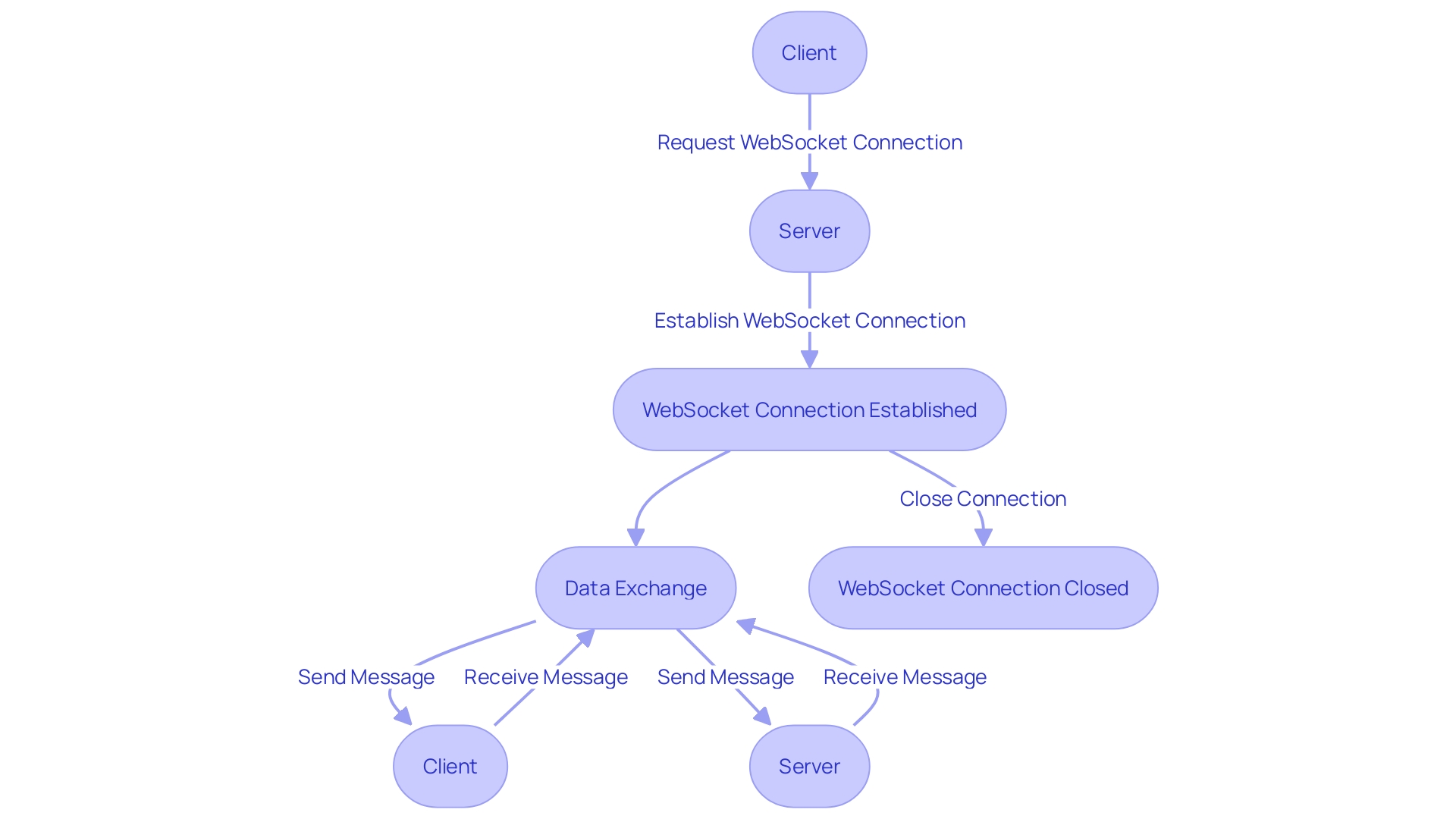
Setting Up a WebSocket API in AWS API Gateway
Setting up a WebSocket API with AWS API Gateway is a transformative step towards real-time communication in web applications, providing a full-duplex, bi-directional channel between clients and servers. Unlike HTTP, WebSocket maintains a persistent connection, allowing for instant data flow without the need to re-establish connections with each exchange. To integrate WebSocket API, begin by configuring routes and their integration points, such as AWS services or Lambda functions, through AWS's intuitive interface.
With the WebSocket API operational, you can effectively manage connections and message exchanges, enabling dynamic functionalities like live chats, gaming interfaces, and collaborative environments.
WebSockets are crucial for applications requiring real-time data, such as NETSOL Technologies' platforms that deliver live scores and collaborative tools. Their implementation must be seamless and robust, as evidenced by Eliot's use of AWS to develop a webhook feature, which underscores the importance of efficient data synchronization. Moreover, events like AWS Innovate Online highlight the significance of mastering technologies like WebSockets to remain competitive.
In the realm of customer engagement, companies like Webio are revolutionizing conversation management without relying on third-party services like Amazon Q or Google Dialog Flow, thus safeguarding consumer data.
In summary, WebSocket APIs are a powerful tool for modern web applications, and AWS API Gateway simplifies their integration. By leveraging this technology, developers can build responsive and engaging user experiences, meeting the growing expectations for instantaneous communication.
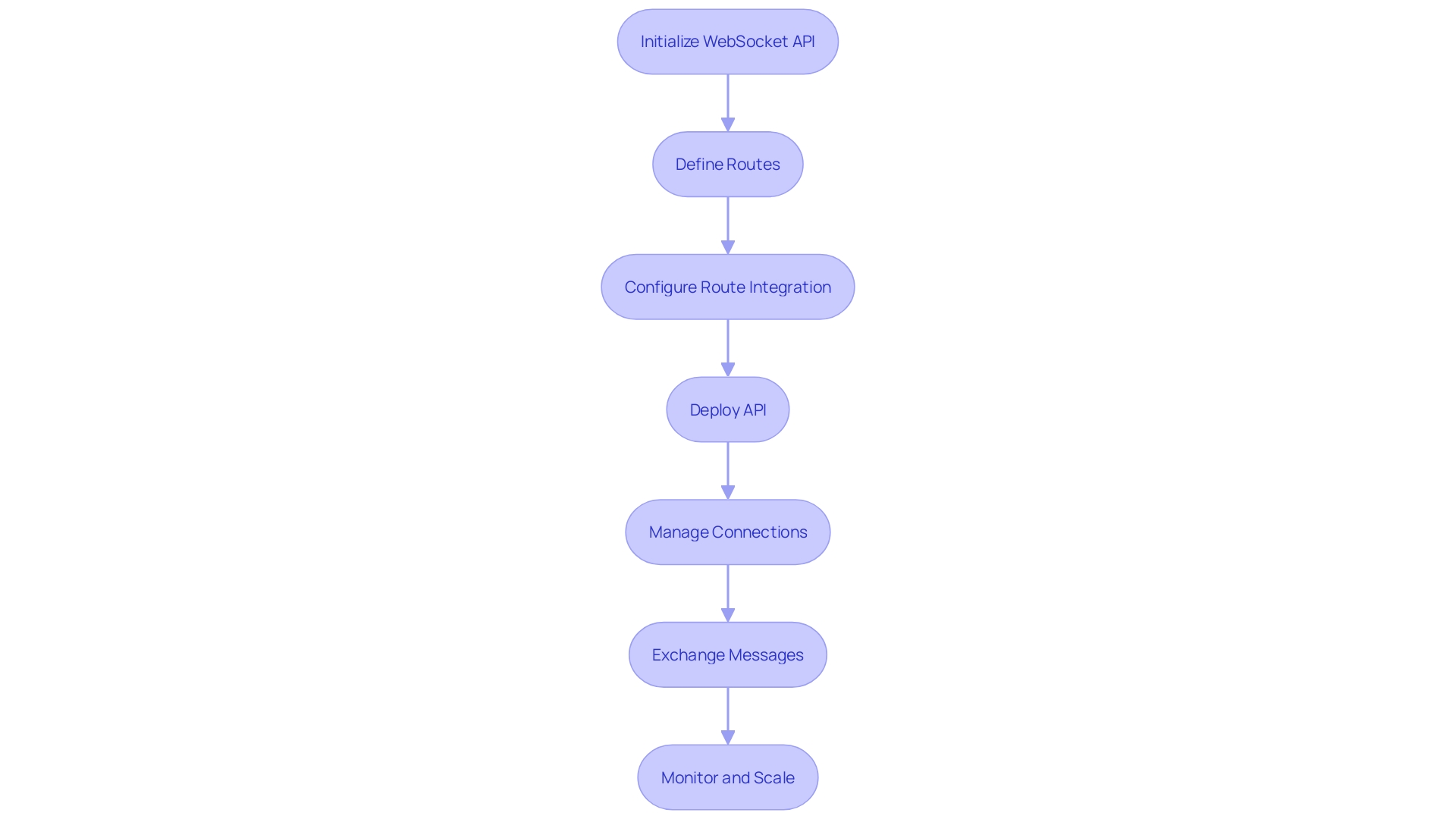
Configuring Routes in WebSocket APIs
WebSocket APIs revolutionize the way clients interact with servers by offering full-duplex communication channels over a single TCP connection. Unlike HTTP, where the dialogue is initiated by the client alone, WebSockets facilitate an ongoing conversation, allowing both client and server to send messages independently of one another. This is made possible through routes that define the API's endpoints and their respective functionalities.
With WebSocket APIs, you can set up specific routes to manage various message types. The connect route activates as soon as a client establishes a WebSocket connection, laying the groundwork for a real-time communication session. Conversely, the disconnect route comes into play when the connection is severed, ensuring any necessary cleanup or termination processes are executed.
For all other messages that don't correspond to predefined routes, default routes are the catch-all solution, efficiently handling incoming data without disrupting the communication flow.
This meticulous configuration of routes is not just a matter of protocol—it's the backbone of a WebSocket API's reliability and performance. As we've witnessed with the advent of real-time web applications and their increasing demand for instantaneous communication, the ability to control and direct the flow of data has never been more critical. By crafting and managing these routes with precision, developers ensure that their WebSocket APIs are not only functional but optimized for the dynamic, real-time web that users expect today.
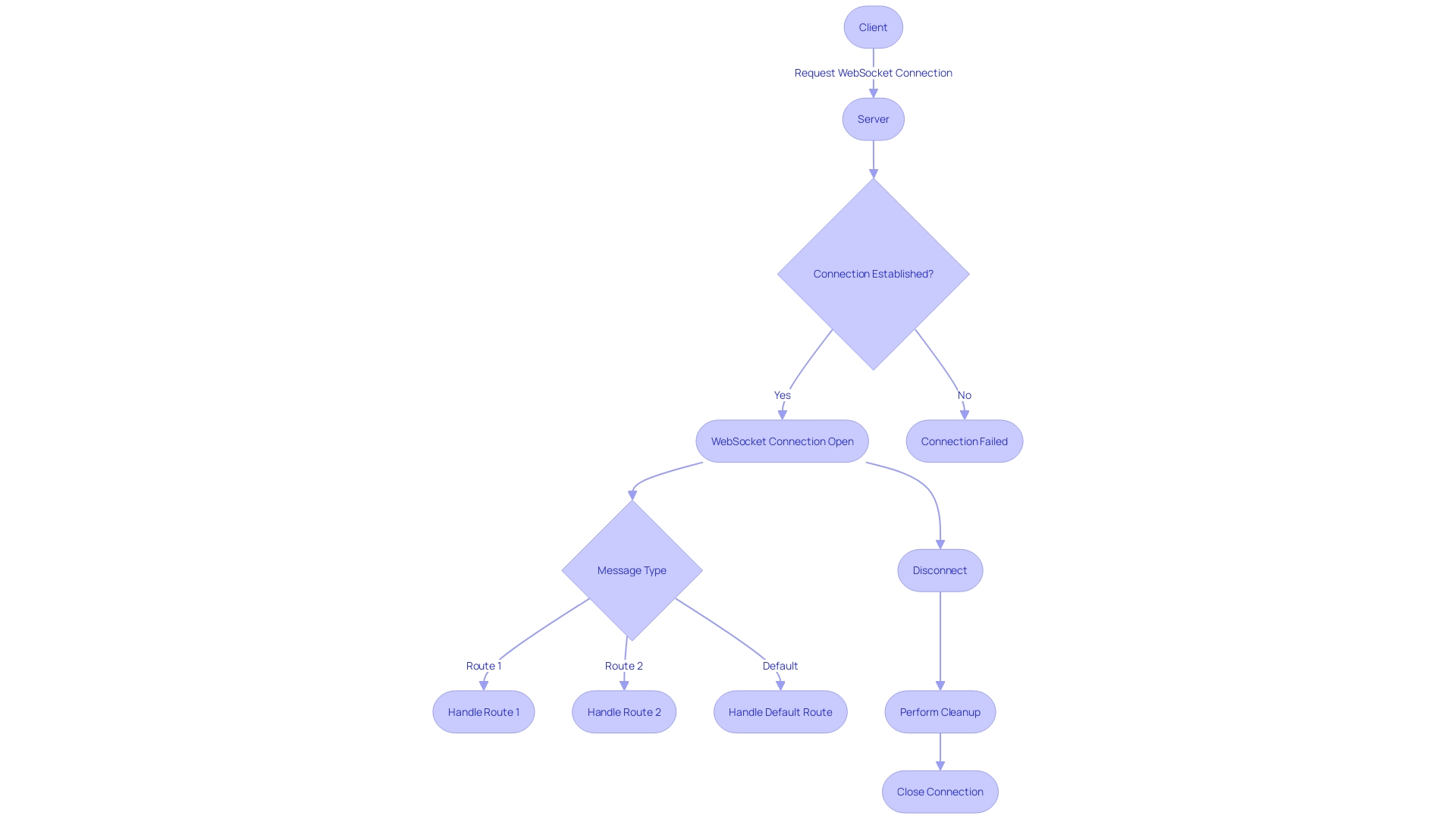
Managing Connections: $connect, $disconnect, and $default Routes
WebSocket APIs are fundamental in creating interactive, real-time applications by providing special routes for managing client-server connections. When a client initiates a WebSocket connection, the $connect route activates, serving as a critical checkpoint for handling authentication and authorization. It's a moment to establish the groundwork for a smooth interaction, ensuring only authorized users gain access and preparing the necessary resources for each client.
Contrastingly, the $disconnect route comes into play when a connection is severed, presenting an opportunity to release resources and perform essential clean-up operations, ensuring system integrity and freeing up resources for other users. Lastly, the $default route is the unsung hero, catching any messages that don't correspond to established routes. It's here where developers can inject custom logic to tailor responses to the unique demands of their applications, offering a flexible solution for handling a variety of interactions.
These routes collectively ensure that WebSocket APIs can deliver seamless, bi-directional communication that has become crucial for modern web services like live chats and instant notifications, as well as for powerhouse companies like Slack and Netflix, where real-time data exchange is non-negotiable.
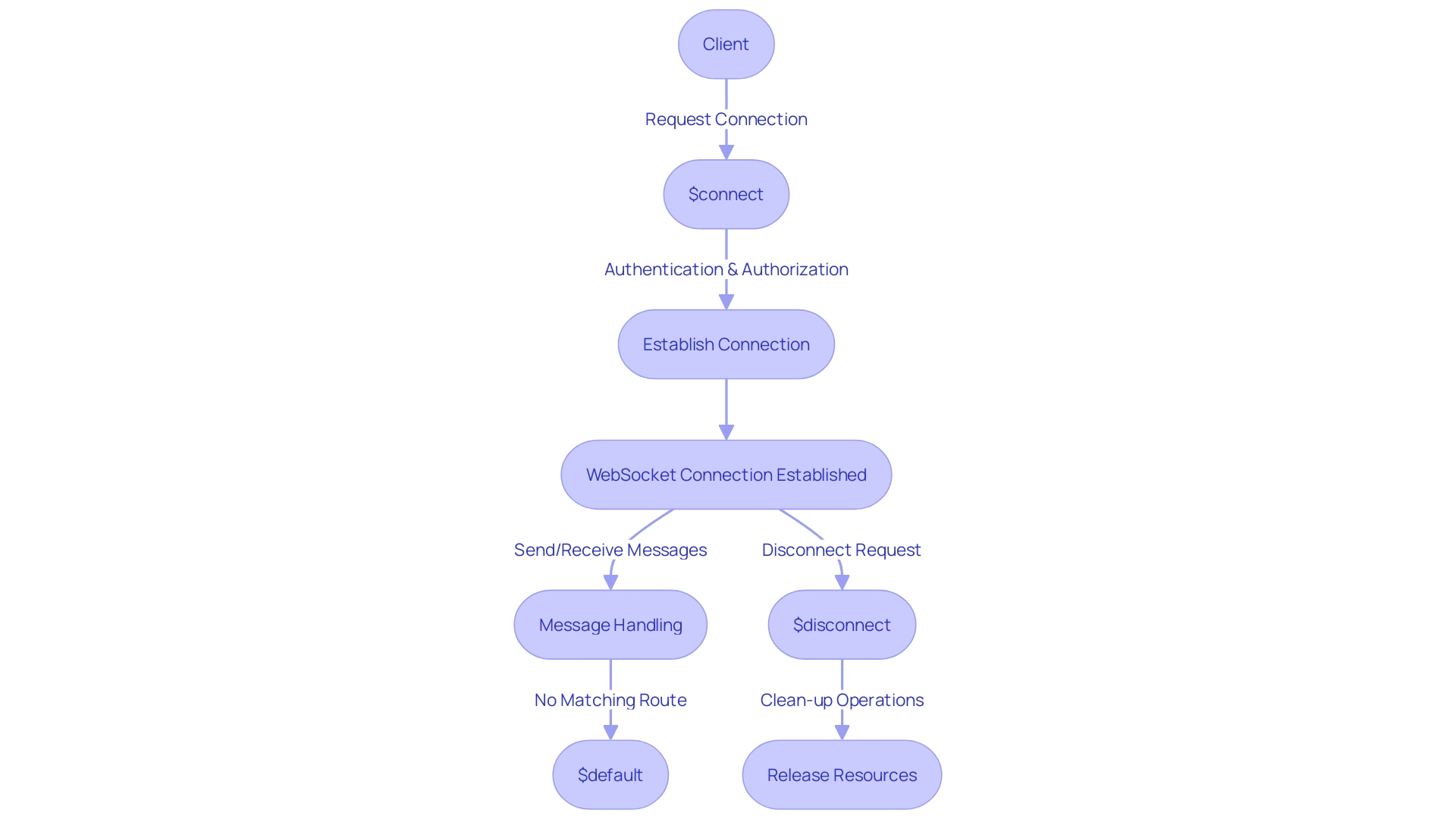
Integrating WebSocket APIs with AWS Lambda
Leveraging AWS Lambda functions in conjunction with WebSocket APIs empowers developers to craft dynamic, real-time applications that respond instantly to user interactions. By mapping Lambda functions to distinct WebSocket routes, developers can deploy complex business logic, seamlessly integrate with diverse AWS services, and engage in various operations such as message validation, data transformation, and database interactivity. This potent integration also caters to generating on-the-fly analytics and initiating supplementary workflows, offering scalability and power in constructing sophisticated applications.
For instance, the interactive auction system devised by Four Nine Digital harnesses the synergy of AWS services, including Amazon Interactive Video Service (IVS) and Chat API, to mimic the exhilarating competitive atmosphere of live auctions. This illustrates the practical application of AWS tools in creating immersive user experiences that are both efficient and engaging.
Real-time communication technology, particularly WebSockets, has seen a surge in popularity due to its full-duplex nature, facilitating bidirectional data flows without the need to repeatedly establish connections with the server. This is essential for applications that depend on live updates and instantaneous user-server communication. However, the choice of technology should align with specific use cases, as alternatives to WebSockets might offer more suitable solutions in certain scenarios.
The necessity for such innovative solutions is underscored by the increasing volume of global internet traffic and the demand for swift, real-time data processing. For example, AWS Lambda has been utilized for mass email dispatches via Simple Email Service, showcasing the platform's cost-effective, serverless capabilities that circumvent the need for significant capital investment in traditional physical and software infrastructures.
As technology progresses, organizations like Cloudflare continue to track internet trends and the growth of online traffic, providing insights into how the digital landscape is evolving. Similarly, the integration of AWS Lambda with WebSocket APIs represents a forward-thinking approach to application development, aligning with the overarching trend towards more interactive, responsive, and efficient web solutions.
Storing Connection IDs: Using DynamoDB or RDS
WebSocket technology has revolutionized real-time communication between servers and clients. As WebSocket applications flourish, the need to effectively manage connection IDs becomes paramount, especially in scenarios involving full-duplex communication channels. AWS steers this innovation by offering two robust storage solutions: DynamoDB and RDS.
DynamoDB, a NoSQL database service, is engineered to handle vast amounts of data and traffic. It ensures seamless scalability and maintains high performance, even as the request capacity and data volume grow. DynamoDB's architecture is designed to distribute data and traffic across multiple servers, safeguarding consistent, swift performance.
This system is particularly advantageous for WebSocket APIs, where managing connection IDs is critical for maintaining user sessions and client-specific information. By leveraging DynamoDB, developers can readily store and access connection IDs, ensuring the persistent, real-time connections that are the hallmark of WebSocket technology.
In contrast, RDS offers a structured, relational database approach. It caters to those who prefer the familiarity and precision of SQL and the ACID transaction model, which guarantees the atomicity, consistency, isolation, and durability of database operations. RDS is ideal for WebSocket APIs that require complex transactions and strict data integrity.
Whether developers choose the scalable, flexible environment of DynamoDB or the structured, transactional integrity of RDS, both AWS services are equipped to optimize WebSocket API performance. The choice hinges on the specific needs of the application, whether it calls for the agile, schema-less design of DynamoDB or the robust transaction support of RDS.
Sending Messages to Connected Clients
WebSocket technology has revolutionized the way servers interact with clients, offering a powerful protocol for real-time communication. Unlike the traditional HTTP model where the client initiates requests and waits for server responses, WebSocket enables a persistent, full-duplex communication channel that allows the server to instantly send data to clients without a need for repeated handshakes. This means you can stream live data, implement instant notifications, and create interactive chat systems with ease, providing users with immediate updates and a seamless online experience.
It's a protocol that's particularly well-suited to applications where speed and efficiency are critical, although it's worth noting that depending on the use case, there may be alternative technologies that could serve specific requirements even better.
Security and Authorization in WebSocket APIs
Understanding WebSocket's vital role in enabling real-time communication is key for appreciating the need for stringent security measures. WebSocket APIs, unlike traditional HTTP, establish a full-duplex communication channel, allowing simultaneous two-way data exchange. This continuous connection is especially crucial for applications requiring instant interactions, like financial services and online gaming.
However, with the increasing popularity of APIs and the rise in API security incidents—78% of cybersecurity teams reported an API-related security breach within a year—it's clear that securing WebSocket APIs is not just important, it's imperative.
API Gateway provides a suite of tools designed to protect WebSocket APIs against unauthorized access and data breaches. Utilizing AWS IAM (Identity and Access Management) is a pivotal strategy for both authentication and authorization, ensuring that only verified clients can connect and interact with the necessary routes. This is particularly significant given that APIs often handle sensitive data, which if compromised, could lead to identity theft or fraudulent activities.
Moreover, implementing SSL/TLS encryption is a critical component for safeguarding data in transit between clients and servers. With the number of internet-connected devices surging and the advent of IoT, lightweight communication protocols like MQTT and AMQP have emerged. However, these protocols may not offer the same level of built-in security as WebSocket, which further underscores the importance of encryption to maintain the integrity of the data flow.
By adopting robust security practices—authentication, authorization, and encryption—developers can create WebSocket APIs that not only meet but exceed the highest standards of security. This not only protects against potential obfuscation techniques used by attackers but also ensures the continuous and real-time flow of data remains secure and reliable in our ever-evolving digital landscape.
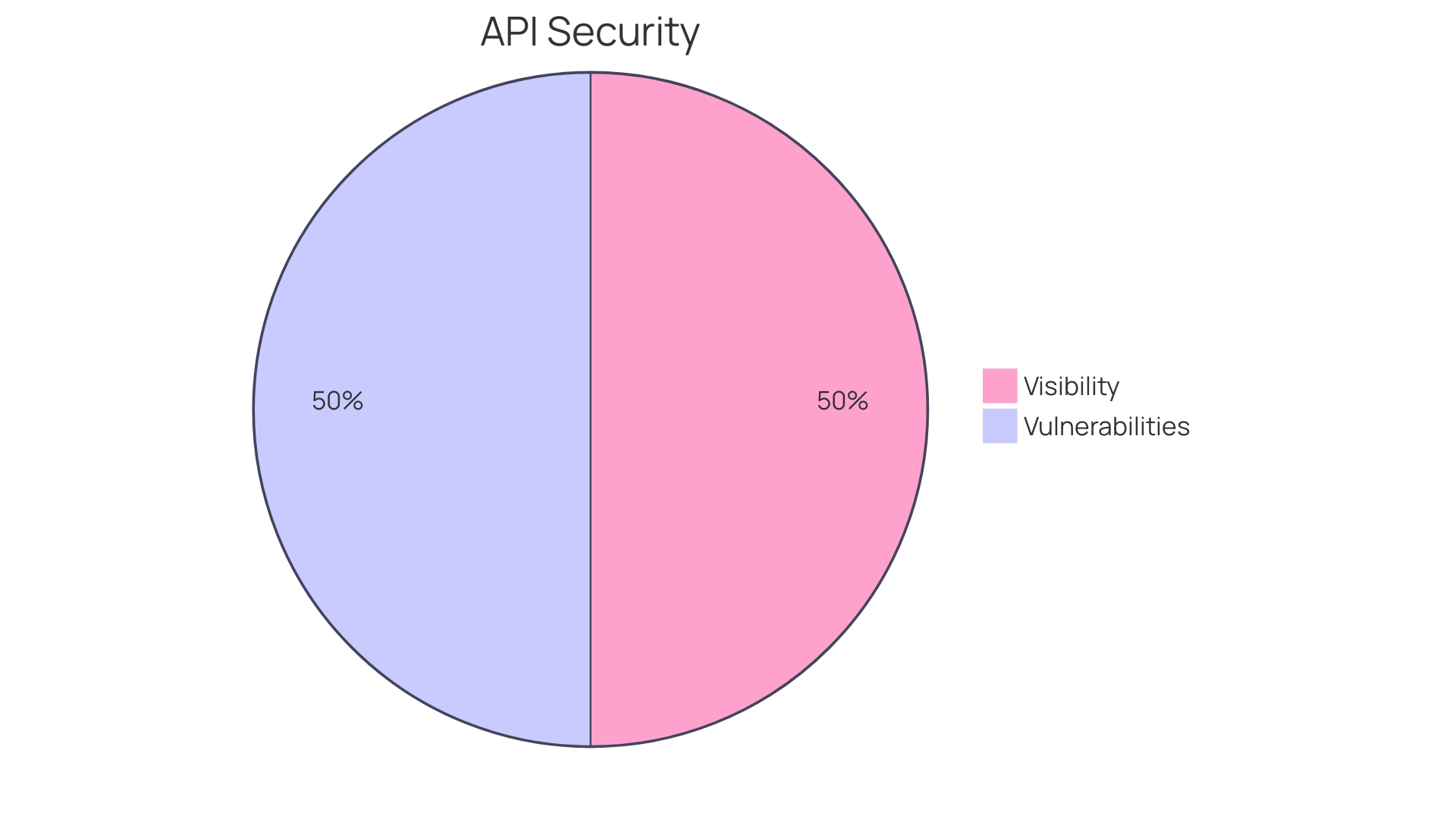
Best Practices and Common Challenges
WebSocket technology is a game-changer for real-time web applications, offering full-duplex communication channels over a single TCP connection, enabling data to flow in both directions simultaneously. This is a significant leap from the traditional HTTP request-response cycle. As developers build WebSocket APIs, it's crucial to adopt best practices for peak performance and reliability.
Efficiently designed routes, graceful error and exception handling, and thorough message validation and sanitization are key. Moreover, it's important to continuously monitor API performance to identify and resolve issues swiftly.
Building robust WebSocket APIs also means overcoming common challenges like handling connection timeouts, ensuring scalability to meet user demand, and maintaining proper message ordering. These considerations are essential for creating seamless, real-time communication experiences on platforms ranging from social networking to customer support systems. With a thoughtful approach to these practices and challenges, developers can craft WebSocket APIs that stand up to the demands of modern web applications, keeping users connected and engaged.
Real-World Applications of WebSocket APIs
WebSocket APIs are transforming the landscape of interactive web applications by providing seamless, bidirectional communication between clients and servers. This advanced protocol, distinct from the traditional HTTP, enables a persistent connection that facilitates instantaneous data exchange, making it ideal for diverse scenarios. Real-time chat applications leverage WebSocket's immediacy to enable conversations that flow as naturally as they would in person.
Collaborative platforms, such as document editing tools, utilize WebSockets to synchronize changes across multiple users instantly, ensuring efficient teamwork even when participants are continents apart.
For the gaming industry, particularly multiplayer online games, the technology is a game-changer. It allows for swift state updates between players, creating a truly interactive and engaging gaming experience. Financial trading platforms also benefit from WebSocket APIs, which provide traders with real-time market data and the ability to execute trades without delay—a critical advantage in a sector where every second counts.
Additionally, live streaming services employ WebSockets to deliver content with minimal latency, keeping viewers engaged with real-time interactions and updates.
As a testament to its versatility and efficiency, WebSocket technology is not limited to entertainment and finance; it extends to any application that relies on live content. From sports scoreboards to IoT device interactions, WebSockets are redefining expectations for real-time digital experiences. Developers seeking to build cutting-edge applications now have a powerful tool in their arsenal with WebSocket APIs, enabling them to innovate beyond the constraints of traditional HTTP communications.
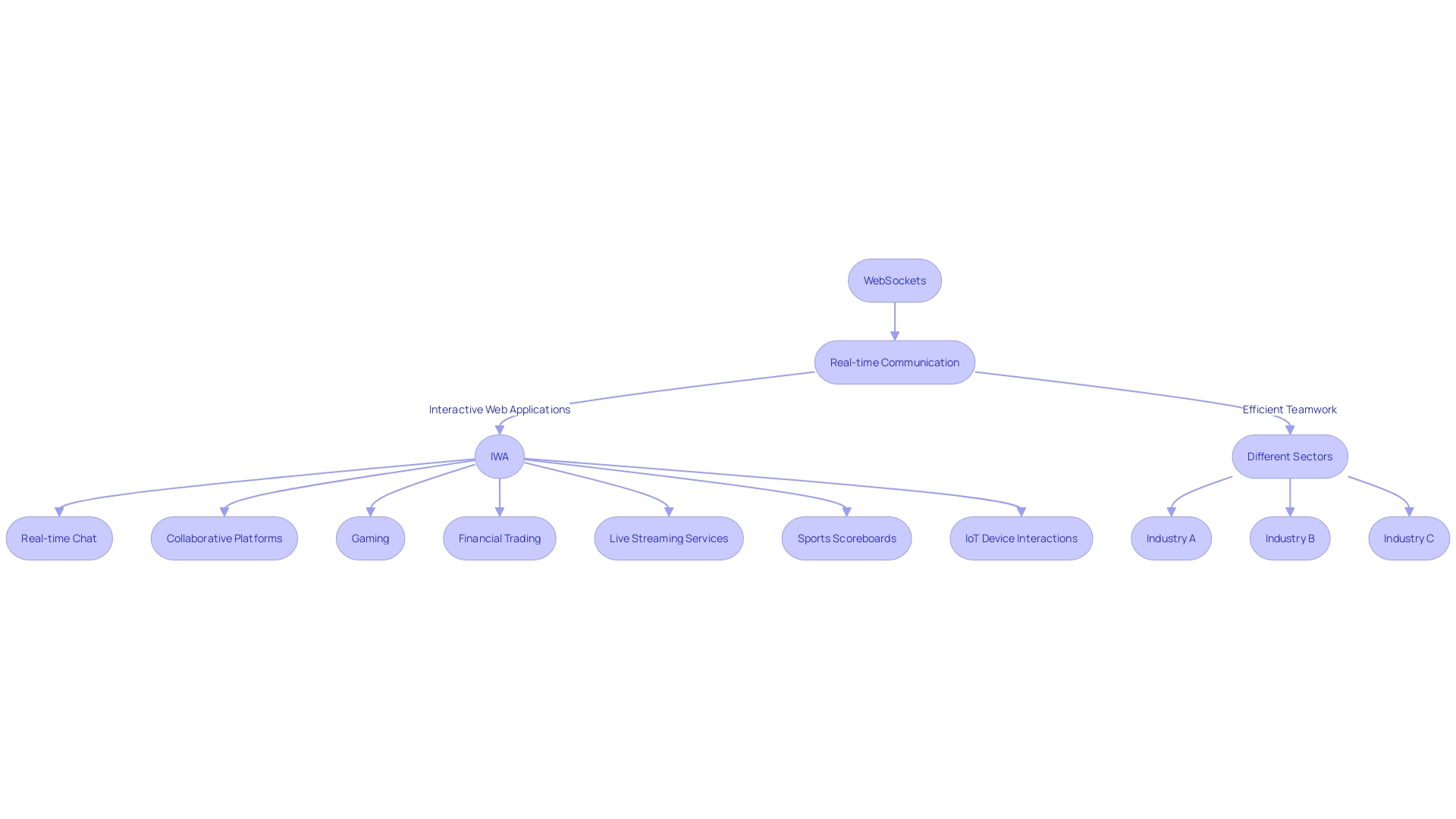
Conclusion
WebSocket technology is a game-changer for real-time web applications, offering a persistent, full-duplex communication channel that enhances performance and responsiveness. It eliminates the need for establishing new connections for each data exchange, slashing latency and improving user experience. Live chat services, collaborative editing environments, and streaming platforms are just a few examples of applications that greatly benefit from WebSocket's capabilities.
WebSocket APIs revolutionize real-time communication by enabling a two-way conversation between client and server. Understanding key concepts like clients, servers, connections, and routes is crucial for leveraging the full potential of WebSocket and building efficient web applications.
Setting up a WebSocket API with AWS API Gateway simplifies real-time communication, providing a full-duplex, bi-directional channel between clients and servers. It allows for instant data flow without the need to re-establish connections, enabling dynamic functionalities like live chats and collaborative environments.
Leveraging WebSocket APIs with AWS Lambda functions empowers developers to create dynamic, real-time applications that respond instantly to user interactions. By mapping Lambda functions to WebSocket routes, developers can deploy complex business logic, seamlessly integrate with AWS services, and perform operations like message validation and data transformation.
WebSocket technology offers a powerful protocol for real-time communication, particularly suited for applications that require speed and efficiency. Security and authorization are crucial aspects of WebSocket APIs, and AWS API Gateway provides tools to protect against unauthorized access and data breaches.
In conclusion, WebSocket technology revolutionizes real-time web applications by providing a persistent, efficient communication channel. Integrating WebSocket APIs with AWS services like API Gateway and Lambda empowers developers to build dynamic and responsive applications. By leveraging the capabilities of WebSocket, developers can meet the growing demands for instantaneous communication in today's digital landscape.
Experience the power of real-time communication with WebSocket technology. Try Kodezi now!
Frequently Asked Questions
What are the advantages of WebSocket APIs over HTTP APIs?
WebSocket APIs allow for persistent, full-duplex communication channels, enabling data to flow seamlessly in both directions without the need for repeated connections. This reduces latency, enhances performance, and is ideal for applications that require instant data updates, such as live chat services, collaborative editing, and streaming platforms.
What is a WebSocket API?
A WebSocket API is a technology that enables a two-way interactive communication session between a client and a server. It allows clients and servers to send messages independently of one another over a single, persistent connection.
How do WebSocket APIs differ from HTTP APIs in terms of communication?
Unlike HTTP APIs, which are designed for one-off, client-initiated transactions, WebSocket APIs maintain a persistent, full-duplex connection that allows for ongoing, bidirectional communication without the need to establish new connections for each message exchange.
What is required to set up a WebSocket API in AWS API Gateway?
To set up a WebSocket API with AWS API Gateway, you need to configure routes and their integration points, such as AWS services or Lambda functions. AWS API Gateway allows for management of connections and message exchanges, facilitating real-time functionalities.
How do WebSocket APIs handle different types of messages?
WebSocket APIs use specific routes to manage various message types. The connect route manages the initial WebSocket connection, the disconnect route handles the closure of connections, and default routes catch all other messages that don't correspond to predefined routes.
What are the special routes in WebSocket APIs for managing connections?
The special routes in WebSocket APIs include $connect for initiating connections, $disconnect for closing connections, and $default for handling messages that do not match any established routes.
How can AWS Lambda be integrated with WebSocket APIs?
AWS Lambda functions can be mapped to distinct WebSocket routes, allowing developers to execute complex business logic, interact with various AWS services, and manage message validation, data transformation, and database operations in real-time.
What are the options for storing connection IDs in WebSocket applications?
AWS offers two storage solutions for connection IDs: DynamoDB, a NoSQL database service for scalable, high-performance needs, and RDS, a relational database service for applications requiring complex transactions and strict data integrity.
How does WebSocket technology enable servers to send messages to connected clients?
WebSocket technology provides a full-duplex communication channel, allowing servers to send data instantly to connected clients without the need for a client request or repeated handshakes.
Why is security and authorization important in WebSocket APIs?
Given the full-duplex communication and the sensitivity of the data often handled by WebSocket APIs, stringent security measures such as authentication, authorization, and encryption are essential to prevent unauthorized access and data breaches.
What are some best practices when building WebSocket APIs?
Best practices include designing efficient routes, handling errors and exceptions gracefully, validating and sanitizing messages, and continuously monitoring API performance to ensure reliability and responsiveness.
What are common challenges in developing WebSocket APIs?
Developers may face challenges such as managing connection timeouts, ensuring scalability, and maintaining proper message ordering. Overcoming these challenges is crucial for creating a seamless real-time communication experience.
What are some real-world applications of WebSocket APIs?
WebSocket APIs are used in real-time chat applications, collaborative platforms, online multiplayer games, financial trading platforms, live streaming services, sports scoreboards, and IoT device interactions, among others. They provide live content and interactive experiences that were not possible with traditional HTTP communications.




